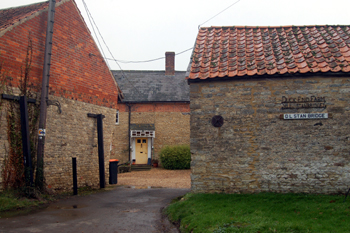Duck End Farm Stevington

Duck End Farm December 2009
Duck End Farmhouse was listed by the former Department of Environment in June 1974 as Grade II, of special interest. The Department dated the building to the 17th or early 18th century and, like many of the older buildings in the area, it is constructed of coursed limestone rubble, though it was heightened in the 19th century with eight courses of red brick. The house has two storeys under a slate roof.
Bedfordshire and Luton Archives and Records Service has notes of some early deeds to the farm bought in temporarily by late owner A. W. Stanbridge [see below] [CRT130Ste5]. The first of these is a marriage settlement for Joseph Barringer of 1700, when he married Alice Barnard. An unnamed farm was entrusted to trustees as part of the settlement. In 1733 a Joseph Barringer of Eltisley [Cambridgeshire], gentleman (perhaps the same man, perhaps a relative), mortgaged a farmhouse, then called Olives Farm, in the occupation of Thomas Wellby, along with 45½ acres of land to secure a loan of £160 from Rev. Thomas Olyffe of Dunton.
Another Joseph Barringer along with Alice Harris (surviving daughter of Joseph and Alice Barringer who had married in 1700), Thomas Collier and Mary Gravestock, grandchildren of Joseph and Alice Barringer, conveyed Olives and its land to John Palmer to 1752 for £550. Palmer's daughter Mary, then widow of John Andrews of Lutterworth [Leicestershire] and living in Olney [Buckinghamshire] and her son John conveyed land in Olney as well as Olives Farm, Stevington to a George Pitt Hurst in 1790. This was so that he could suffer a common recovery which would, in fact, strengthen the Andrews' title to the property.
William Andrews was in possession of the farm by 1814 and in his will, proved in 1837, left all his real estate in Stevington, Stagsden, Olney and Emberton [Buckinghamshire] to his sons Thomas Palmer Andrews and William Andrews and trustee Joseph Palmer for them to sell. This happened in 1841 when they conveyed Olives Farm (then in the occupation of a man named Fobee) to T. A. Green of Pavenham for £3,648. After Green's death West End and Duck End Farms (so-called for the first time) in Stevington and Picts Hill in Turvey were put up for sale by auction in 1856. Duck End Farm then comprised 134 acres, 3 roods, 21 poles and was in the occupation of John Keech. Keech purchased Picts Hill Farm and quit his tenancy of Duck End Farm, which had been bought by Edward Turney, the outgoing tenant of Picts Hill Farm! In 1861 Edward Turney conveyed the farm to Charles Turney in trust and he to Thomas Turney in 1863. Directories of 1894, 1898, 1903 and 1910, 1914 and 1920 list Amos Maxey Turney at Duck End Farm.
The Rating and Valuation Act 1925 specified that every building and piece of land in the country was to be assessed to determine its rateable value. Stevington was assessed in 1926 and the valuer visiting Duck End Farm [DV1/H8/6] noted that it was owned and occupied by A. W. Stanbridge, who had bought it in 1923, and that it contained 102 acres. The valuer commented: "useful holding, plenty of grass, Elms".
The house comprised two reception rooms, a kitchen, scullery, pantry and washhouse and privy. A bathroom ("but no water") and three bedrooms lay upstairs. The valuer commented: "Damp but otherwise good".
The homestead comprised the following buildings of which the valuer remarked: "Buildings mostly stone with various Roofings, Drainage runs to waste.No water, made for 160 acres":
- North-north-west: a workshop, garage and double calf box;
- North-west: a three division loose box and barn;
- North-east: a two bay open hovel, four loose boxes and a cow place for ten beasts;
- South-south-west: a three bay open hovel;
- North-west: a barn and stable for six horses and, behind, a hen house and loose box. There was also a granary "on the same wing";
- South-south-west: a rickyard with a four bay open hovel.